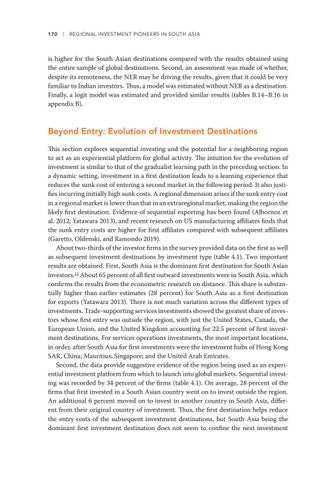170 l REGIONAL INVESTMENT PIONEERS IN SOUTH ASIA
is higher for the South Asian destinations compared with the results obtained using the entire sample of global destinations. Second, an assessment was made of whether, despite its remoteness, the NER may be driving the results, given that it could be very familiar to Indian investors. Thus, a model was estimated without NER as a destination. Finally, a logit model was estimated and provided similar results (tables B.14–B.16 in appendix B).
Beyond Entry: Evolution of Investment Destinations This section explores sequential investing and the potential for a neighboring region to act as an experiential platform for global activity. The intuition for the evolution of investment is similar to that of the gradualist learning path in the preceding section. In a dynamic setting, investment in a first destination leads to a learning experience that reduces the sunk cost of entering a second market in the following period. It also justifies incurring initially high sunk costs. A regional dimension arises if the sunk entry cost in a regional market is lower than that in an extraregional market, making the region the likely first destination. Evidence of sequential exporting has been found (Albornoz et al. 2012; Yatawara 2013), and recent research on US manufacturing affiliates finds that the sunk entry costs are higher for first affiliates compared with subsequent affiliates (Garetto, Oldenski, and Ramondo 2019). About two-thirds of the investor firms in the survey provided data on the first as well as subsequent investment destinations by investment type (table 4.1). Two important results are obtained. First, South Asia is the dominant first destination for South Asian investors.13 About 65 percent of all first outward investments were in South Asia, which confirms the results from the econometric research on distance. This share is substantially higher than earlier estimates (28 percent) for South Asia as a first destination for exports (Yatawara 2013). There is not much variation across the different types of investments. Trade-supporting services investments showed the greatest share of investors whose first entry was outside the region, with just the United States, Canada, the European Union, and the United Kingdom accounting for 22.5 percent of first investment destinations. For services operations investments, the most important locations, in order, after South Asia for first investments were the investment hubs of Hong Kong SAR, China; Mauritius; Singapore; and the United Arab Emirates. Second, the data provide suggestive evidence of the region being used as an experiential investment platform from which to launch into global markets. Sequential investing was recorded by 34 percent of the firms (table 4.1). On average, 28 percent of the firms that first invested in a South Asian country went on to invest outside the region. An additional 6 percent moved on to invest in another country in South Asia, different from their original country of investment. Thus, the first destination helps reduce the entry costs of the subsequent investment destinations, but South Asia being the dominant first investment destination does not seem to confine the next investment

